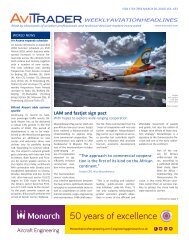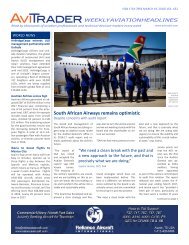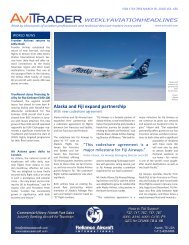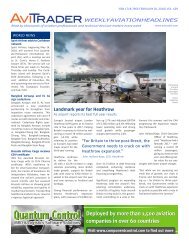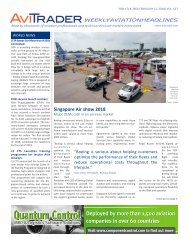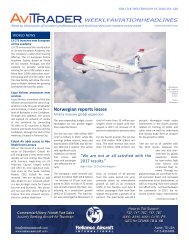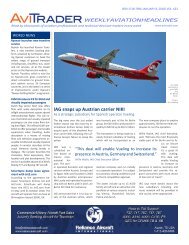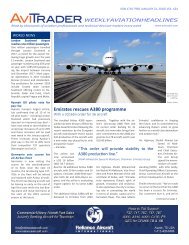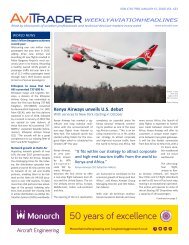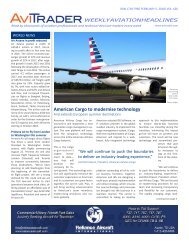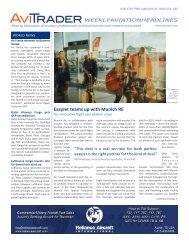AviTrader_Monthly_MRO_e-Magazine_2016-06
AviTrader_Monthly_MRO_e-Magazine_2016-06
AviTrader_Monthly_MRO_e-Magazine_2016-06
Create successful ePaper yourself
Turn your PDF publications into a flip-book with our unique Google optimized e-Paper software.
Leasing and pooling: Engine parts supply (forecasting demand)<br />
20<br />
looks at both long-term [strategic] and short-term [tactical] horizons to<br />
ensure we have both whole engine and inventory spares available to<br />
support fleet demand.”<br />
Software enabling capabilities that aid to forecast demand for engine<br />
parts already exists, but some experts believe there are too many variables<br />
to manage the wholesale supply properly.<br />
These days the global demand for spare parts is driven almost exclusively<br />
by the OEM and its level of participation in the <strong>MRO</strong> aftermarket.<br />
Usually, where the OEM has complete control of the aftermarket there<br />
is no material supply because of the control exerted by the OEM.<br />
Analysts observe that when an OEM is very active in the aftermarket<br />
such as Rolls Royce, the engagement of the surplus material providers<br />
is inverse to the OEM’s involvement.<br />
Its necessary for engine parts suppliers to<br />
forecast demand.<br />
Photo: Pratt & Whitney<br />
for more effective sharing of information and greater collaboration.<br />
As stated, forecasting spares demand involves a great deal of information.<br />
Spares forecasting requires various types of internal and external<br />
data collection prior to using manual and/or statistical-based forecasting<br />
tools.<br />
Engine owners will ultimately want to improve their inventory flow. Industry<br />
experts recommend that engine owners could improve their inventory<br />
flow by working closely with the industry to reduce costs taking<br />
advantage of the surplus equipment coming available to reduce total<br />
<strong>MRO</strong> costs for ESV’s.<br />
AAR looks at global trends in fleet demand and some of the volatility<br />
patterns on certain engine types to ensure it has engines available. “We<br />
But this data is hugely confidential and each OEM and parts supplier<br />
guards this information carefully. Therefore organisations are unlikely<br />
to share detailed models and forecasts with the market, that said, suppliers<br />
and <strong>MRO</strong>s will often share information under non-disclosure type<br />
agreements to develop mutually beneficial supply agreements.<br />
Engine parts suppliers use various data points, either historical or proactively<br />
to ensure they have the right level of surplus spares available to<br />
satisfy the markets requirements.<br />
Some companies have a complex algorithm that forecasts spares<br />
demand on an aggregate as well as on an engine model by engine<br />
model basis.<br />
Glover adds that spares forecasting must be tailored to a customer’s<br />
unique requirements. He says whole engine spares forecasting is strategic<br />
in nature to ensure engine availability for fleet usage and thrust<br />
availability. “It becomes more tactical when considering the impacts of<br />
seasonality, flight hour peaks, network changes, and other impacting<br />
factors such as AD and SB compliance. AAR’s spares forecasting model<br />
Glover says there is a continual<br />
demand for leasing especially for<br />
narrow-body engines<br />
maintain a ‘close-to-the-customer’ business model that verifies market<br />
intelligence and helps effectively plan for proper support,” says Glover.<br />
AAR also works alongside a number of its key customers (operators and<br />
owners) to forecast their ESV demand schedules with consideration of<br />
shop capacities to ensure AAR can support engine spares and material<br />
demands when required. This information sharing looks at engine<br />
trends monitoring, EGT, on condition items alongside hard time LLP<br />
removals. “In an ideal world, there will always be spares available for<br />
the operators; this is where communication is key and AAR can help,”<br />
Glover states.<br />
Topham from Werner stresses that engine parts suppliers basically need<br />
to understand the demand for engine shop visits (performance restoration<br />
and full overhauls) which drive the main consumption of parts.<br />
Parts pooling is typical for engine accessories.<br />
Photo: FL Technics<br />
Demand forecasting information and the resulting inventory, manufacturing,<br />
and <strong>MRO</strong> capacity to meet the predictable and unexpected<br />
needs of the commercial aviation market are critical as growth expands.<br />
<strong>AviTrader</strong> <strong>MRO</strong> - June <strong>2016</strong>





